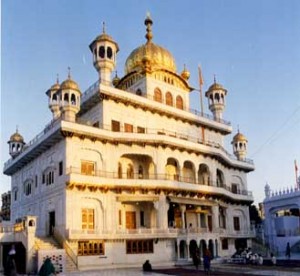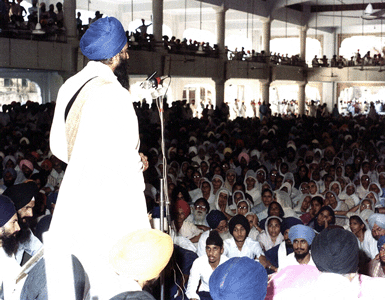


Akal Takht is the highest temporal seat of [the Sikh community and literally] means the throne of the immortal. The Jathedar of Akal Takht is the highest spokesperson of Sikh panth and is meant to be [a] spiritual leader without any control or influence from outside or politically motivated sources. The present Jathedar of Akal Takht is Gyani Gurbachan Singh, [who was appointed by the SGPC with strong influence from the Governments of Punjab and India].
Akal Takht was established as a place where both the temporal and spiritual concerns of Sikhs could be acted upon.
History of Akal Takht
[Akal Takht Sahib] was founded by sixth Sikh Guru, Guru Hargobind Sahib on June 15, 1606 (now celebrated on July 2) and was established on the principle of Miri and Piri, where Miri signifies temporal authority and Piri, spiritual authority. Guru Hargobind himself wore two swords of Miri and Piri.



Two years after [the] installation of Adi Ganth in Harmandir Sahib, [the] fifth Sikh Guru, Guru Arjan Dev Ji was brutally tortured to death by Mughal emperor Jahangir. His martyrdom transformed Sikh character from purely spiritual to [include] the martial aspect as well for protection of the masses. Anticipating his death, Guru Arjan Dev had asked his son Hargobind to “sit fully armed on his throne and maintain an army.”
At the tender age of eleven, Guru Hargobind Sahib at the ceremony of ascension, wore a sword-belt with two swords of Miri and Piri and made it clear that Sikhs were going to be an armed community which would protect the interests of not only the Sikhs but underprivileged and down trodden as well.
On Monday, fifth day of Har, Samvat 1663, Guru Hargobind laid foundation of Akal Takht. The original structure of Akal Takht, built by Guru Hargobind Sahib and Baba Buddha Ji, remarked that seat of [the] Guru will serve Sikh panth for eternity.
The platform of Takht was raised to twelve feet, in defiance to the edict of Jahangir that no other person except emperor himself could sit on a raised platform of more than three feet. Guru would regularly sat on the platform, with all marks of royalty and dispensed justice for all Sikh disputes.
It is worth mentioning that Akal Takht was built a fraction lower than Harmandir Sahib, signifying that spirituality was always prime in Sikhism.
Significance of Akal Takht
All the hukamnamas related to Sikh community regarding any guidance or clarification are issued from Akal Takht. Any person found violating religious discipline or with activity prejudicial to Sikh interests or solidarity is declared ‘tankhaiya’ by Akal Takht and has to complete penance charges as decided by the Sikh clergy.




